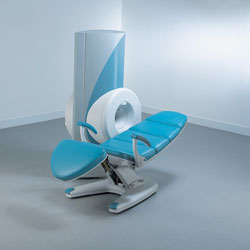 | Info
Sheets |
| | | | | | | | | | | | | | | | | | | | | | | | |
 | Out-
side |
| | | | |
|
| | | | | |  | Searchterm 'Resolution' was also found in the following services: | | | | |
|  |  |
| |
|
MS-325 is the formerly code name of gadofosveset trisodium (new trade name Vasovist). MS-325 belongs to a new class of blood pool agents for magnetic resonance angiography ( MRA) to diagnose vascular disease. Gadofosveset trisodium has ten times the signal-enhancing power of existing contrast agents as well as prolonged retention in the blood. This enables the rapid acquisition of high resolution MRA's using standard MRI machines.
Gadofosveset trisodium, which is gadolinium-based, stays in the blood stream as a result of transient binding to albumin. Albumin binding offers an additional benefit beyond localization in the blood pool. The contrast agent begins to spin much more slowly, at the rate albumin spins, causing a relaxivity gain that produces a substantially brighter signal than would be possible with freely circulating gadolinium.
MS-325 is an intravascular contrast agent intended for use in MRI as an aid in diagnosing aortoiliac occlusive disease in patients with known or suspected peripheral vascular disease (PVD) or abdominal aortic aneurysm (AAA).
Currently clinical trials completed for peripheral vascular disease and coronary artery disease. Additional trials are also being conducted to evaluate MS-325 as an aid in diagnosing breast cancer and suggested that it might be feasible to combine the use of MS-325, injected during peak stress, with delayed high- resolution imaging to identify myocardial perfusion defects.
Vasovist (MS-325) would compete with the contrast agents Ferumoxytol ( Code 7228) from AMAG Pharmaceuticals, Inc. and NC100150 Injection from Nycomed Amersham, but their further development is uncertain.
Partners in development: EPIX Pharmaceuticals, Inc., Mallinckrodt Inc., and Bayer Schering Pharma AG. Bayer Schering Pharma has the worldwide marketing rights for the product.
Formerly known under the Mallinckrodt trademark name, AngioMARK®.
See also Classifications, Characteristics, etc. | |  | |
• View the NEWS results for 'MS-325' (10).
| | | | |  Further Reading: Further Reading: | News & More:
|
|
| |
|  |  | Searchterm 'Resolution' was also found in the following services: | | | | |
|  |  |
| |
|

From ONI Medical Systems, Inc.;
MSK-ExtremeÔäó MRI system is a dedicated high field extremity imaging device, designed to provide orthopedic surgeons and other physicians with detailed diagnostic images of the foot, ankle, knee, hand, wrist and elbow, all with the clinical confidence and advantages derived from high field, whole body MRI units. The light weight (less than 650 kg) of the OrthOne System performs rapid patient studies, is easy to operate, has a patient friendly open environment and can be installed in a practice office or hospital, all at a cost similar to a low field extremity machine.
New features include a more powerful operating system that offers increased scan speed as well as a 160-mm knee coil with higher signal to noise ratio, and the option of a CD burner.
Device Information and Specification 16 cm knee, 18 cm lower extremity;; 12.3 cm upper extremity, additional high resolution v-SPEC Coils: 80 mm, 100 mm, or 145 mm. SE, FSE, GE2D, GE3D, Inversion recovery (IR), Driven Equilibrium, Fat Saturation (FS), STIR, MT, PD, Flow Compensation (FC), RF spoiling, MTE, No Phase Wrap (NPW) IMAGING MODES Scout, single, multislice, volume 2D less than 200 msec/image X/Y: 64-512; 2 pixel steps 4,096 grey lvls; 256 lvls in 3D POWER REQUIREMENTS 115VAC, 1phase, 20A; 208VAC, 3 phase, 30A COOLING SYSTEM TYPE LHe with 2 stage cold head 1.25m radial x 1.8m axial | |  | | | |  Further Reading: Further Reading: | Basics:
|
|
| |
|  | |  |  | |  |  | Searchterm 'Resolution' was also found in the following services: | | | | |
|  |  |
| |
|
| |  | |
• View the DATABASE results for 'Partial Averaging' (4).
| | | | |
|  |  | Searchterm 'Resolution' was also found in the following services: | | | | |
|  |  |
| |
|
| |  | |
• View the DATABASE results for 'Partial Fourier Imaging' (5).
| | | | |
|  | |  |  |
|  | |
|  | | |
|
| |
 | Look
Ups |
| |